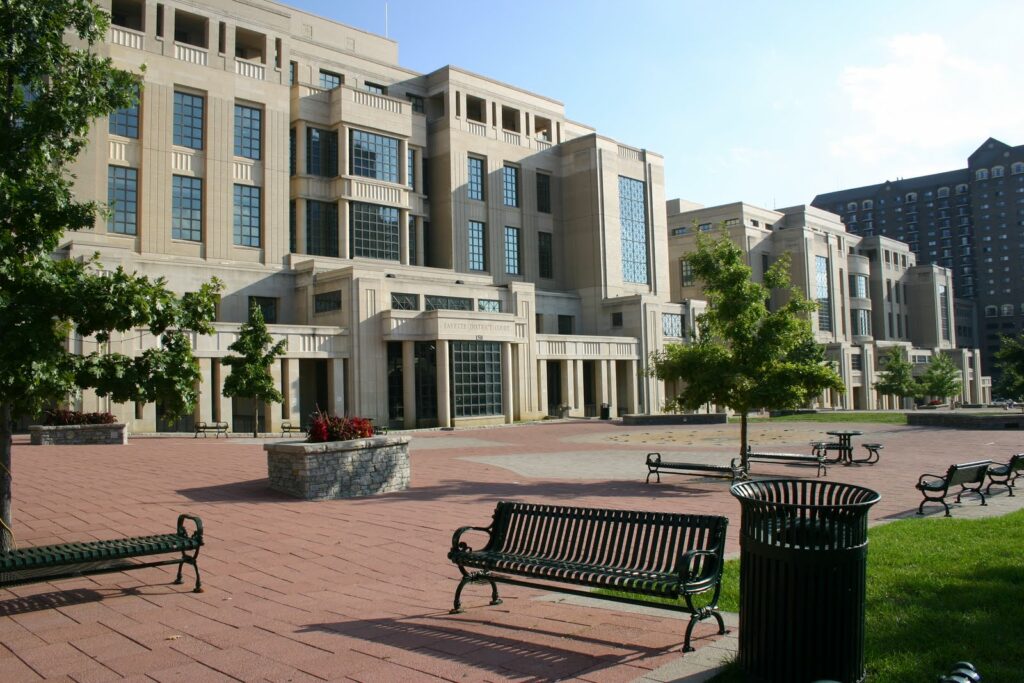Hopefully Peter won’t be too upset, but I decided to just get Fayette over with today. Pictured below are the new Circuit and District Court buildings at the corner of Main and Limestone. They don’t bother me as much as they apparently bother others, though I do absolutely love the old courthouse above, which is now the History Center. There are TONS of stories to be told about this old courthouse (Cheapside Park, the statutes, the water fountains, etc.) but I’m going to let Peter tell you those, because he knows those stories better than I do. All I know is that this is the FIFTH courthouse to sit on this spot, and based on the pictures in some of my Lexington history books, most of them were really really beautiful buildings.
So, Peter…whatcha know?
Category: Uncategorized
Powell County Courthouse – Stanton, Ky.

Powell County’s courthouse looks like a middle school. Not that there is anything wrong with it, but it just looks very 80s. Honestly, it completely blends in and I almost didn’t realize what it was before I passed it. The drive through Stanton was pleasant, as this concluded my drive back from Eastern Kentucky on this beautiful cool Kentucky day. Among the most interesting things I learned about Powell County’s courthouse was its Civil War history. It was among the many Kentucky courthouses burned during the Civil War, but Powell County’s courthouse had the unique honor of having been burned down TWICE during the Civil War. Man, that would be rough.
Wolfe County Courthouse – Campton, Ky.

This was the first time on this trip when I’ve been a little creeped out. On the way down the highway towards Campton, there was this KSP officer who swung his car out behind me as if to pull me over. I got that feeling everyone knows in my stomach, because I really really thought I was getting pulled over. Then he flew by me, and then about a mile up the road pulled another huge U-turn and went back the other way.
Then as I came into Campton, (which was a ghost town by the way) the creepiness factor went through the roof. When I pulled up to the courthouse, what I believe to be the SAME COP pulled into the courthouse square. The courthouse square was completely empty except me and this cop. He walked into the courthouse after giving me a stare and that was it. I snapped my picture and got out of there.
It was an interesting courthouse, but in desperate need of some TLC. Paint was chipping all over the place. Interestingly, this area of Kentucky was mentioned in John Swift’s journals as containing huge silver mines. However, no trace of these reputed silver mines have ever been found. Also, Wolfe County was named after Nathaniel Wolfe, who was allegedly the first graduate of the University of Virginia.
Breathitt County Courthouse – Jackson, Ky.
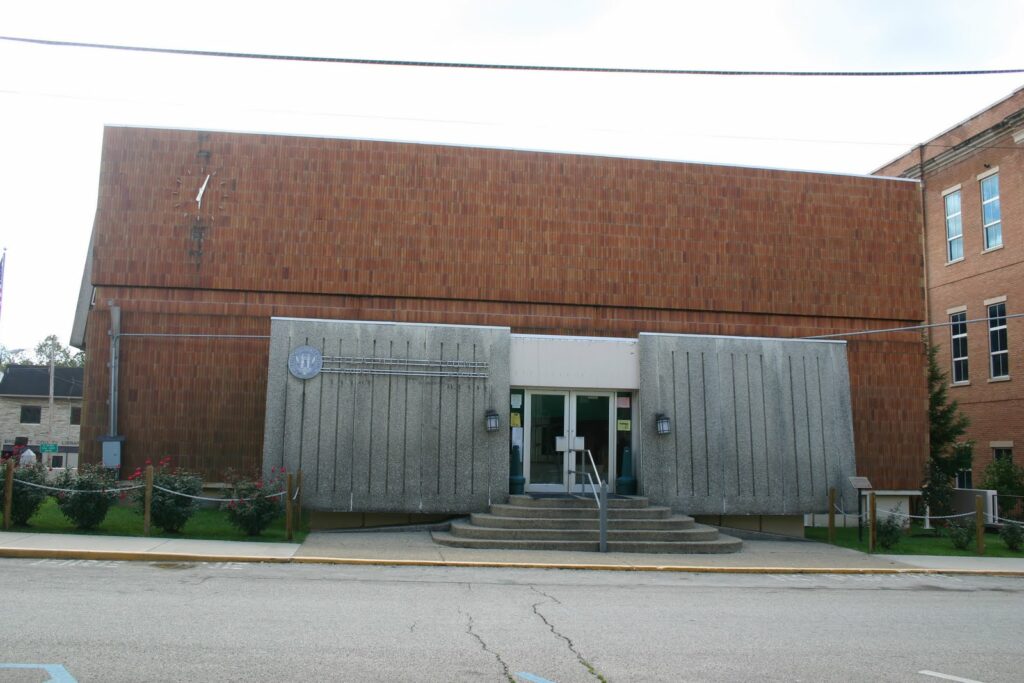
Ouch. This is the Breathitt County Courthouse in Jackson. I’ve never quite really understood Jackson, starting with the fact that the sewage treatment plant stands right along the major road through town. The smell is as bad as you imagine. And this picture above was the best I could do of the Breathitt County Courthouse. Again, the newer Judicial Center next door, pictured below, was much more attractive.
 I knew nothing about Jackson’s history, but according to the historical markers, this was the epicenter of the “feudin’ and fightin'” history of Eastern Kentucky. The courthouse that stood here from 1899 to 1963 was a landmark of this time period. From 1870 to 1920, stemming from family disagreements and political differences, more than 100 Breathitt County officials were killed. Forty men were killed in 11 months between 1901 and 1902.
I knew nothing about Jackson’s history, but according to the historical markers, this was the epicenter of the “feudin’ and fightin'” history of Eastern Kentucky. The courthouse that stood here from 1899 to 1963 was a landmark of this time period. From 1870 to 1920, stemming from family disagreements and political differences, more than 100 Breathitt County officials were killed. Forty men were killed in 11 months between 1901 and 1902.
Perry County Courthouse – Hazard, Ky.

Perry County was one of two places I visited today where the new judicial center is MUCH more attractive than the old courthouse. Here, the judicial center is on the left, and the courthouse on the right. I put in an extra picture of the judicial center, just so you get an idea how cool it looks
.

There’s a fountain in there next to the benches, and the judicial center really fits in and enhances the downtown area.
Hazard was founded by Elijah Combs, who came here along with his seven brothers in 1790. Interestingly, Hazard and Perry County are named after the same person – Commodore Oliver Hazard Perry.
On my way out of town, I stopped in a drug store parking lot on the bypass and took the picture at the bottom of this post.
Letcher County Courthouse – Whitesburg, Ky.
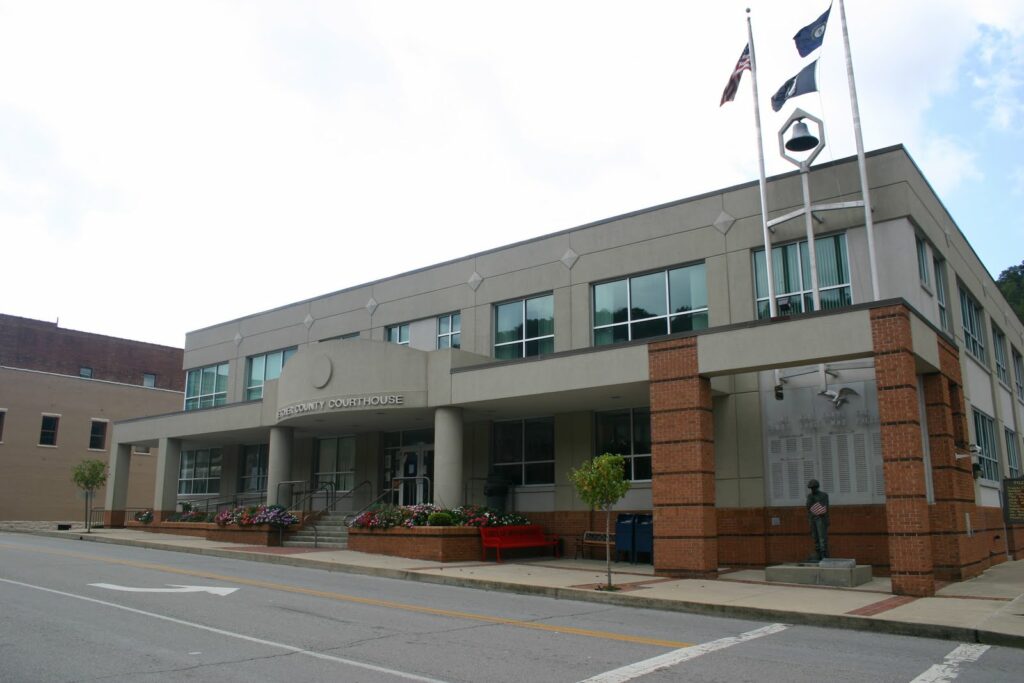
Whitesburg and Letcher County hold a special place in my heart, because this is where my wife and her family are from. We travel through the mountains a couple of times each year and visit the ‘Burg, as I like to call it, and it is a uniquely charming place. From the amazing “Speak Your Piece” section of the newspaper (where anyone can write in and say ANYTHING – offensive, libelous, you name it), to the annual Mountain Heritage Festival, Whitesburg is an interesting little place. This weekend was the Mountain Heritage Festival, which was a little dampened by the constant rain showers. But, I got to listen to some country music and eat a deep fried miniature pecan pie, so all was right with the world. I also picked up some fresh peach butter and snapped this picture of Letcher’s courthouse. In celebration of Mountain Heritage, the windows up and down Main Street were filled with old pictures of the prominent mountain families, and some pretty amazing pictures of the courthouse that used to stand in this spot. My father in law tells me that this current courthouse is much better than the “purple courthouse” that was there before renovations. Apparently the windows were supposed to be blue, but in the sun, they turned purple.
No Destination: The Roebling Bridge
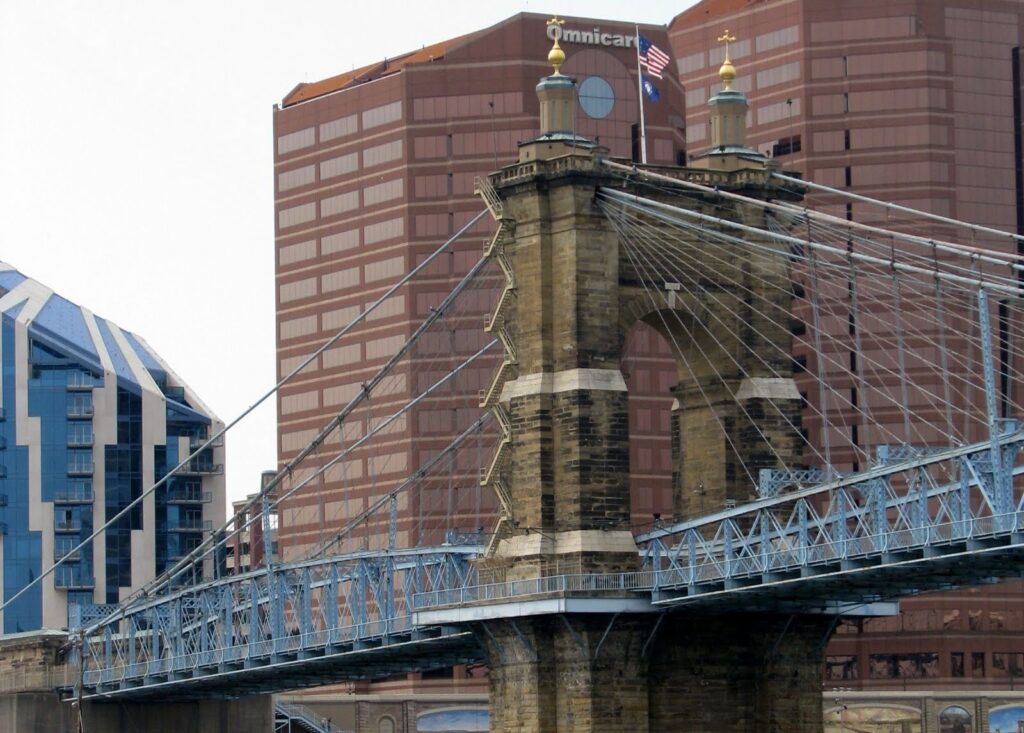 I had plans to go with a friend to last weekend’s Kentucky-Miami (OH) football game at Paul Brown Stadium in Cincinnati, Ohio. To get there, I took the interstate but only as far as the river. We parked in Newport, had a pitcher of beer at the Beer Sellar on the river, and boarded a water taxi which ferried us across and down the river to a spot between the stadium and the baseball ballpark (they do the same thing before Reds’ games).
I had plans to go with a friend to last weekend’s Kentucky-Miami (OH) football game at Paul Brown Stadium in Cincinnati, Ohio. To get there, I took the interstate but only as far as the river. We parked in Newport, had a pitcher of beer at the Beer Sellar on the river, and boarded a water taxi which ferried us across and down the river to a spot between the stadium and the baseball ballpark (they do the same thing before Reds’ games).
Aside from enjoying a few minutes on the water, one of the biggest perks was traveling under the Roebling Bridge. Named after its architect, John A. Roebling, the bridge was constructed over a ten-year span and was completed in 1867.
If either the name Roebling or the appearance of the bridge seem familiar to you, they are. After finishing the Cincinnati-Covington bridge, Roebling’s services were utilized in the construction of the Brooklyn Bridge which began in 1870 and concluded in 1883. The similarities between the two bridges are clear.
At 1,224 feet, the Roebling Bridge was (at the time of its completion) the world’s longest suspension bridge. This record was surpassed by the Brooklyn Bridge which spanned 1,595 feet.
Also pictured (far left) is the Ascent at Roebling’s Bridge, a 22-story condominium project that was designed by Daniel Libeskind. The structure won world-wide aclaim and was named the best high-rise in America in 2008 by CNBC. I first noticed the Ascent from the Reds’ ballpark during a July 2008 game and it is certainly a beautiful building.
Oh, and Kentucky won the game, 42-0. Go Cats!
No Destination: Winchester
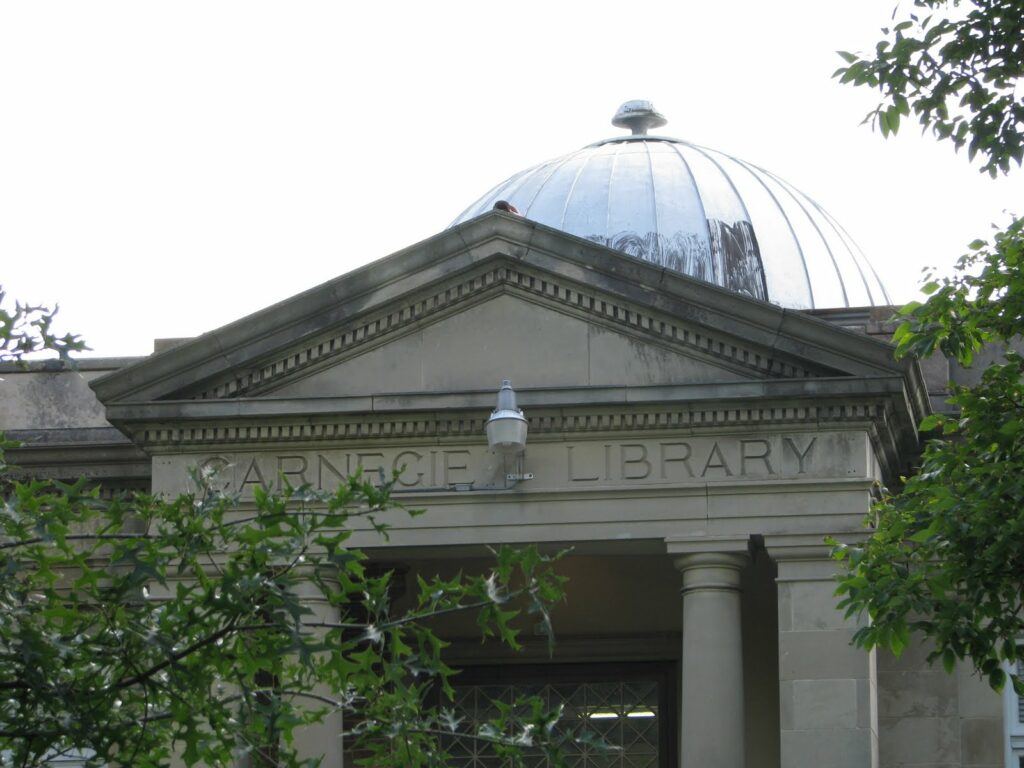 After leaving the Howard’s Creek area in southern Clark County, I traveled north on Boone Avenue (KY 627). After his courthouse visit, Nate had told me about the great oddity of Winchester: College Street.
After leaving the Howard’s Creek area in southern Clark County, I traveled north on Boone Avenue (KY 627). After his courthouse visit, Nate had told me about the great oddity of Winchester: College Street.
Look far and wide, but there is no remaining college on College Street or elsewhere in Winchester. But, from 1890 to 1954, Winchester was the home of Kentucky Wesleyan College; it has since relocated to Owensboro. Among its most notable alumna, Supreme Court Chief Justice Stanley Reed (1902).
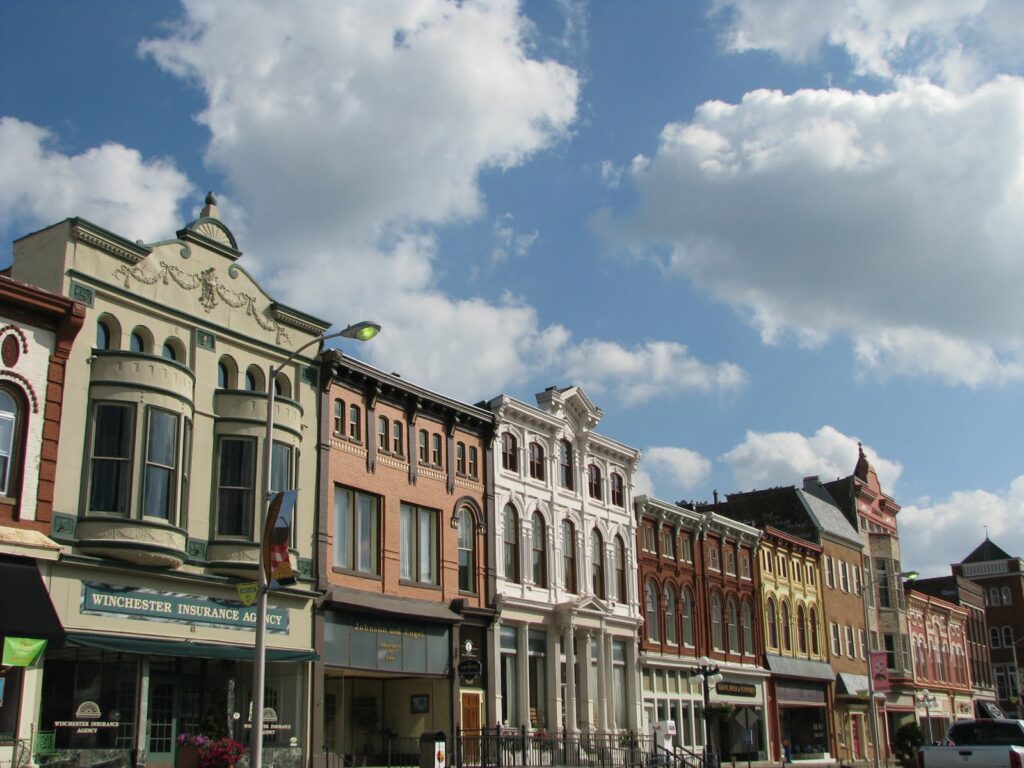 The old college grounds are now a city park and some of the campus buildings remain. The Carnegie Library (c. 1914) is now a community center (a child’s birthday party was going on during my campus visit) and the Spencer Memorial Gymnasium is currently being expanded and converted into the city natatorium.
The old college grounds are now a city park and some of the campus buildings remain. The Carnegie Library (c. 1914) is now a community center (a child’s birthday party was going on during my campus visit) and the Spencer Memorial Gymnasium is currently being expanded and converted into the city natatorium.
Downtown Winchester has many small, locally owned and operated businesses. The historic buildings are mostly well-kept, in repair and freshly painted. The downtown area is dominated by, as Nate put it, a “massive” whitewashed courthouse.
Leaving Winchester, I drove past the Ale-8-One bottling plant. Ale-8-One is a Kentucky soft drink that is most like a ginger ale, but that would still be an inaccurate description. Introduced in 1926, the soda has a limited distribution area but it is “the drink” in Winchester. I saw countless young teenagers milling around drinking from the iconic glass green bottle.
A final note: Helen Thomas, journalist and White House correspondent for every President since John F. Kennedy was born in Winchester. Regrettably, there is no historical marker related to Ms. Thomas in Winchester.
No Destination: Howard’s Creek (Providence) Church
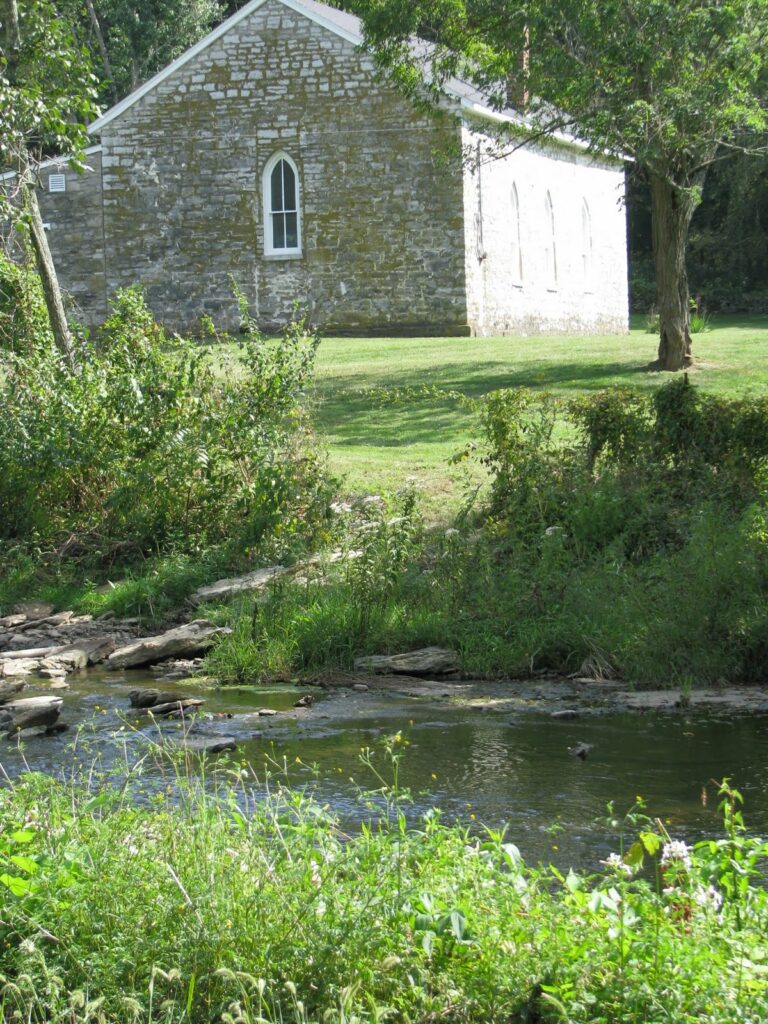 I continued without destination by heading east from Athens. I have found that a No Destination trek is made more comfortable with the GPS feature on the iPhone as I could take a few extra turns with the knowledge that I was merely on a detour and not going down a dead-end.
I continued without destination by heading east from Athens. I have found that a No Destination trek is made more comfortable with the GPS feature on the iPhone as I could take a few extra turns with the knowledge that I was merely on a detour and not going down a dead-end.
I found Grimes Mill Road – just inside Clark County – to be breathtaking. The beautiful stone home, the red barns and the bridge over the stream all captured eras past. Minutes later, I find myself peering in the windows of a cafe & bakery at Combs Ferry. It was closed, but not out of business as large sacks of organic sidamo coffee beans lay on the floor.
Uncertain as to whether my destination for the day would be McKee, Winchester or Paris, I saw a historic marker and followed the path down which it led. The church at Howard’s Creek was regularly attended by Daniel Boone. In 1790, the church was renamed “Providence” and the present stone structure was contructed by William Bush, who was a member of Boone’s second Kentucky expedition. According to the historic marker, the church “passed to Negro Baptists, 1870.”
After a heavy rain, the road to the church would be under water at two points. It was a beautiful, short drive to the church and the old, stone building was picturesque. As I walked up to the church on a Saturday, I noticed the freshly mowed grass. As I snapped a few pictures, the minister came out and we exchanged greetings.
He had been preparing the Sunday sermon for his flock at the Providence Missionary Baptist Church. About 14 attend weekly, and the church remains a black baptist congregation. It also remains as the oldest Baptist church west of the Alleghenies.
No Destination: Athens
 Leaving my home in Nicholasville, I traveled through eastern Jessamine County and southern Fayette County before arriving in the small community of Athens (pronounced with a long “A”, AY-thənz). Located in rural Fayette County (but part of Lexington-Fayette due to the 1974 merger of city and county), Athens was first settled in 1786 and was chartered in 1826.
Leaving my home in Nicholasville, I traveled through eastern Jessamine County and southern Fayette County before arriving in the small community of Athens (pronounced with a long “A”, AY-thənz). Located in rural Fayette County (but part of Lexington-Fayette due to the 1974 merger of city and county), Athens was first settled in 1786 and was chartered in 1826.
Originally known as “Cross Plains,” it has been suggested that the name “Athens” is a reference to Lexington’s old nickname, “The Athens of the West.” The nickname was a statement of Lexington’s educational and societal strength during the early- to mid-1800s.
The village was a manufacturing center until most of the town had burned by 1860 (according to the National Trust for Historic Preservation, which listed the Athens historic district in 1979, a major fire occurred in 1853-54). Today, Athens is nothing more than a crossroads. The old Athens Elementary School was closed a few years ago and is now used as an antique mall.
What remains of the historic district sits at the crossroads: the Aubrey Inn (c. 1800) and the Marshall Tavern (c. 1840). These two brick structures have been well-cared for and are surprisingly imposing for this little hamlet; clear evidence of what once was.


